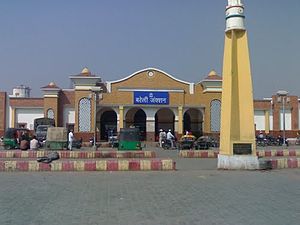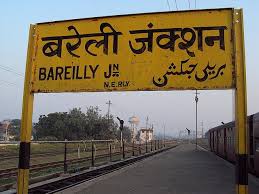 Bareilly Railway Station or Bareilly Junction (Hindi: बरेली जंक्शन, Urdu: بریلی جنکشن) (station code BE) is one of the most, important railway stations in Northern India. New Delhi (just 250 km.), the capital of India, is an important Station near Bareilly from where trains to Mumbai, Chennai, Bengaluru, Hyderabad and to most of the places in India are available. However, some important trains to other parts of the country also touch/originate at this station. Bareilly Junction is the station that serves both the Broad and Standard gauge.
Bareilly Railway Station or Bareilly Junction (Hindi: बरेली जंक्शन, Urdu: بریلی جنکشن) (station code BE) is one of the most, important railway stations in Northern India. New Delhi (just 250 km.), the capital of India, is an important Station near Bareilly from where trains to Mumbai, Chennai, Bengaluru, Hyderabad and to most of the places in India are available. However, some important trains to other parts of the country also touch/originate at this station. Bareilly Junction is the station that serves both the Broad and Standard gauge.
Indian railway system connects Bareilly directly with New Delhi- the Capital of India, Lucknow- the Capital of Uttar Pradesh, Ahmedabad, Jammu tawi, Chandigarh, Dehradun, Kolkata, Aligarh, Mathura, Kathgodam (near Nainital) etc.There are intercity train between Bareilly, Meerut and Lucknow.In addition currently, six railway stations is able to serve the city including Bareilly Junction (serving both the Broad and Standard gauge) itself. A few mail express and passenger trains also connect Bareilly to Roza, Faurrakabad. Mumbai LTT Bareilly Express is weekly train used to identifies Bareilly with Mumbai
Bareilly railway station is a significant railway station of Uttar Pradesh state of India. New Delhi, the capital of the Republic of India is situated at the distance of 250 km from Bareilly. Trains for all major cities of India such as Mumbai, New Delhi, Bengaluru, Chennai, Hyderabad and for some other cities of India halt at the Bareilly railway station. Trains are easily available at the station for going to nearby cities. Both broad gauge lines and standard gauge lines are used to serve Bareilly Junction.
Bareilly is a well known city located in Bareilly district. It is located on the banks of Ramganga river. This prominent city is not only the capital of the Bareilly division but it is also the capital of the Rohilkhand Division. Apart from being an important place for manufacturing furniture, the city is famous for its trade in cotton, grain and sugar.
 Bareilly is well-connected with the rest of the country through railways from the 19th century. An official map of 1909 shows that Bareilly was a prominent railway junction during the 20th century. Six railway tracks intersect in the city. In 1890, the Bengal and North Western Railway took over management of the Tirhoot State Railway (under a lease) in an effort to increase the latter’s profitability. The Lucknow-Sitapur-Seramow Provincial State Railway merged with the Bareilly-Pilibheet Provincial State Railway to form the Lucknow-Bareilly Railway on 1 January 1891. The Lucknow-Bareilly Railway was owned by the Government of India and worked by the Rohilkund and Kumaon Railway.
Bareilly is well-connected with the rest of the country through railways from the 19th century. An official map of 1909 shows that Bareilly was a prominent railway junction during the 20th century. Six railway tracks intersect in the city. In 1890, the Bengal and North Western Railway took over management of the Tirhoot State Railway (under a lease) in an effort to increase the latter’s profitability. The Lucknow-Sitapur-Seramow Provincial State Railway merged with the Bareilly-Pilibheet Provincial State Railway to form the Lucknow-Bareilly Railway on 1 January 1891. The Lucknow-Bareilly Railway was owned by the Government of India and worked by the Rohilkund and Kumaon Railway.
The Oudh and Tirhut Railway company operated the railway line until 1943 and managed a number of lines until 1943, when it was amalgamated with the Rohilkund and Kumaon Railway and the Lucknow Bareilly Railway. It became the Oudh-Tirhut Railway. All existing contracts were terminated and it became an entirely state-owned enterprise.
The Oudh and Tirhut Railway was formed on 1 January 1943 by the amalgamation of the Bengal and North Western Railway, the Tirhut Railway (BNW worked), the Mashrak-Thawe Extension Railway,(BNW worked), the Rohilkund and Kumaon Railway and the Lucknow-Bareilly Railway (R&K worked). The Oudh and Tirhut Railway was later renamed the Oudh Tirhut Railway and merged with the Assam Railway to form the North Eastern Railway on 14 April 1952.
Its headquarters was at Gorakhpur. On 14 April 1952, the Oudh and Tirhut Railway was amalgamated with the Assam Railway and the Kanpur-Achnera section of the Bombay, Baroda and Central India Railway to form North Eastern Railway, one of the 16 zones of the Indian Railways.
Bareilly city stations:
Bareilly has numerous railway stations apart from Bareilly junction(serving Broad gauge) i.e. Bareilly City(serving Broad gauge), Izzat Nagar(serving the Meter Gauge & Broad gauge), Chenheti Station (serving the Broad gauge), Bhojipura Station (serving the Meter Gauge & Broad gauge), C.B. Ganj Station (serving the Broad gauge).
